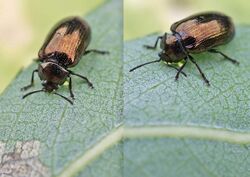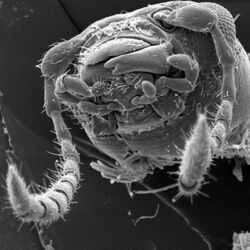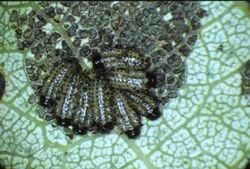Biology:Phratora
| Phratora | |
|---|---|

| |
| Scientific classification | |
| Domain: | Eukaryota |
| Kingdom: | Animalia |
| Phylum: | Arthropoda |
| Class: | Insecta |
| Order: | Coleoptera |
| Infraorder: | Cucujiformia |
| Family: | Chrysomelidae |
| Tribe: | Chrysomelini |
| Genus: | Phratora Chevrolat in Dejean, 1836 |
| Synonyms | |
|
Phyllodecta Kirby, 1837 | |
Phratora is a genus of leaf beetles. It is synonymous to Phyllodecta .[1] European Phratora species can be distinguished based on morphology of female genitalia.,[2] but they differ little in size and body form and most show metallic coloration.[3]
Distribution
Phratora species are found in the Northern Hemisphere in areas that tend to be cool and moist where their host plants thrive.[4] They are usually found in Northern and Southern Europe,[3] China and Japan,[5][6][7] and in Canada and the United States of America.[8][1]
Host plants
Species in this genus are of considerable interest to evolutionary ecology researchers because they vary with respect to host plant preference and chemistry of their larval defensive secretions.[8] Phratora species are known to feed on willows (Phratora americana, P. frosti, P. interstitialis, P. tibialis, Phratora vitellinae, Phratora vulgatissima, P. polaris, P. purpurea), poplars (Phratora laticollis, P. atrovirens, Phratora vitellinae, P. purpurea), or birch (P. polaris in Lapland, Phratora hudsonia), and their host plant use is evolutionarily conserved in that closely related beetle species tend to feed on more closely related plant species.[8][9]
Natural enemies
Predators of Phratora eggs include A. nemorum, Orthotylus marginalisand the syrphid fly Parasyrphus nigritarsis.[10] Larval predators include A. nemorum, the bug Rhacognathus punctatus,[10] and the wasp Symmorphus bifasciatus.[11] Adult beetles are consumed by R. punctatus.[10] More information about natural enemies can be found in the articles about Phratora laticollis, Phratora vitellinae and Phratora vulgatissima.
Larval defense secretions
The mechanism of larval defensive secretion production, its relationship to host plant preference, and its evolutionary significance has been studied.[12][13] The secretions can repel natural enemies or conspecifics.[14] More information about larval secretions can be found in the articles about Phratora laticollis and Phratora vitellinae.
Economic Importance
Some species (especially Phratora vulgatissima) are considered pests when populations build up in willow plantations.[15]
Species
These 16 species belong to the genus Phratora:
- Phratora americana (Schaeffer, 1928) i c g b
- Phratora antennaria (Apfelbeck, 1912) g
- Phratora atrovirens (Cornelius, 1857) g
- Phratora californica Brown, 1961 i c g
- Phratora frosti Brown, 1951 i c g
- Phratora hudsonia Brown, 1951 i c g b (birch leaf beetle)
- Phratora interstitialis Mannerheim, 1853 i c g b
- Phratora kenaiensis Brown, 1952 i c g
- Phratora koreana Takizawa, 1985 g
- Phratora laticollis (Suffrian, 1851) g
- Phratora polaris (Sparre Schneider, 1886) g
- Phratora purpurea Brown, 1951 i c g b (aspen skeletonizer)
- Phratora similis (Chujo, 1958) g
- Phratora tibialis (Suffrian, 1851) g
- Phratora vitellinae (Linnaeus, 1758) g (brassy leaf beetle)
- Phratora vulgatissima (Linnaeus, 1758) g (blue willow leaf beetle)
Data sources: i = ITIS,[16] c = Catalogue of Life,[17] g = GBIF,[18] b = Bugguide.net[19]
References
- ↑ 1.0 1.1 W. J. Brown (1951). "The American Species of Phratora Chev. (Coleoptera: Chrysomelidae)". The Canadian Entomologist 83 (5): 121–130. doi:10.4039/Ent83121-5. http://journals.cambridge.org/action/displayAbstract?fromPage=online&aid=8574887.
- ↑ Sundholm, A. (1956). "Studien über die Gattung Phyllodecta Kirby (Col. Chrysomelidae)". Opuscula Entomologica 21: 5–7.
- ↑ 3.0 3.1 Görnandt, H. (1955). "Die Käfergattung Phyllodecta Kirby". Deutsche Entomologische Zeitschrift 2: 1–100. doi:10.1002/mmnd.19550020102.
- ↑ Silverberg, H. (1994). "Chrysomelidae in the Arctic". in P. H. Jolivet. Novel aspects of the biology of Chrysomelidae. 50. Dordrecht: Kluwer Academic. pp. 503–510.
- ↑ Shuyong, W. (1992). "Coleoptera: Chrysomelidae- Chrysomelinae". Insects of the Hengduan Mountains Region 1 (5): 628–645.
- ↑ Chen, S. H. (1965). "On the Chinese species of the Chrysomeline genus Phratora". Acta Zootaxonomica Sinica 2 (3): 218–224.
- ↑ Gressitt, J. L.; Kimoto, S. (1963). "The Chrysomelidae (Coleopt.) of China and Korea, Part 2". Pacific Insects Monograph 1b: 301–1026.
- ↑ 8.0 8.1 8.2 8.3 Köpf, A.; Rank, N. E.; Roininen, H.; Julkunen-Tiitto, R.; Pasteels, J. M.; Tahvanainen, J. (1998). "The evolution of host-plant use and sequestration in the leaf beetle genus Phratora (Coleoptera: Chrysomelidae)". Evolution 52 (2): 517–528. doi:10.1111/j.1558-5646.1998.tb01651.x. PMID 28568343.
- ↑ Canty, Roy; Ruzzier, Enrico; Cronk, Quentin C.; Percy, Diana M. (2019). "Salix transect of Europe: additional leaf beetle (Chrysomelidae) records and insights from chrysomelid DNA barcoding". Biodiversity Data Journal 7: e46663. doi:10.3897/BDJ.7.e46663. PMID 31736630.
- ↑ 10.0 10.1 10.2 Rank, N. E.; Smiley, J. T.; Köpf, A. (1996). "Natural enemies and host plant relationships for chrysomeline leaf beetles feeding on Salicaceae". in P. H. Jolivet. Chrysomelidae Biology. 2: Ecological Studies. Amsterdam: SPB Publishing. pp. 147–171.
- ↑ Blüthgen, P. (1961). Die Faltenwespen Mitteleuropas (Hymenoptera, Diploptera). Berlin: Akademie Verlag.
- ↑ Soetens, P.; Pasteels, J. M.; Daloze, D. (1993-11-01). "A simple method for in vivo testing of glandular enzymatic activity on potential precursors of larval defensive compounds in Phratora species (Coleoptera: Chrysomelinae)". Experientia 49 (11): 1024–1026. doi:10.1007/BF02125653. ISSN 1420-9071.
- ↑ Termonia, A.; Hsiao, T. H.; Pasteels, J. M.; Milinkovitch, M. C. (2001). "Feeding specialization and host-derived chemical defense in Chrysomeline leaf beetles did not lead to an evolutionary dead end". Proceedings of the National Academy of Sciences, USA 98 (7): 3909–3914. doi:10.1073/pnas.061034598. PMID 11259651. Bibcode: 2001PNAS...98.3909T.
- ↑ Hilker, M. (1989). "Intra- and interspecific effects of larval secretions in some chrysomelids (Coleoptera)". Entomologia Experimentalis et Applicata 53 (3): 237–245. doi:10.1111/j.1570-7458.1989.tb03571.x.
- ↑ J. Stenberg; A. Lehrman; C. Björkman (2010). "Uncoupling direct and indirect plant defences: Novel opportunities for improving crop security in willow plantations". Agriculture, Ecosystems and Environment 139 (4): 528–533. doi:10.1016/j.agee.2010.09.013.
- ↑ "Phratora Report". https://www.itis.gov/servlet/SingleRpt/SingleRpt?search_topic=TSN&search_value=719652.
- ↑ "Browse Phratora". http://www.catalogueoflife.org/col/browse/tree/id/73124d079183782054d81147e131d4b9.
- ↑ "Phratora". https://www.gbif.org/species/1048862.
- ↑ "Phratora Genus Information". https://bugguide.net/node/view/40583.
Further reading
- American Beetles, Volume II: Polyphaga: Scarabaeoidea through Curculionoidea. CRC Press. 2002. ISBN 978-0849309540.
- Clark, S.M.; Le Doux, D.G.; Riley, E.G.; Gilbert, A.J. et al. (2004). Host Plants of Leaf Beetle Species Occurring in the United States and Canada. Coleopterists Society. ISBN 9780972608732.
- Riley, Edward G.; Clark, Shawn M.; Seeno, Terry N. (2003). Catalog of the leaf beetles of America north of Mexico (Coleoptera: Megalopodidae, Orsodacnidae and Chrysomelidae, excluding Bruchinae). Special Publication. The Coleopterists Society. ISBN 0-9726087-1-0.
External links
Wikidata ☰ Q662803 entry
 |






